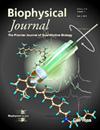Isomerization of PhotoGb3 in Phase-separated Pore-spanning Membranes alters Shiga toxin Organization.
IF 3.2
3区 生物学
Q2 BIOPHYSICS
引用次数: 0
Abstract
The lateral organization of Shiga toxin bound to a lipid membrane is significantly influenced by the fatty acid geometry of its receptor glycolipid Gb3, which is crucial for the protein's internalization into the host cell. To control the lipid geometry, we used a photoisomerizable azobenzene derivative of Gb3 (photo-Gb3) that can be switched between a trans- and cis-configuration under light. We reconstituted this photo-Gb3 into liquid-disordered (ld)/liquid-ordered (lo) phase-separated pore-spanning membranes (PSMs), creating freestanding bilayer parts (f-PSMs) composed of an lo-phase surrounded by ld-phase on the pore rims (s-PSMs). Upon UV irradiation, we observed small, mobile, and transient ld-domains in the f-PSMs, indicating a trans-to-cis-isomerization of the photo-Gb3. The mean diffusion coefficient of the ld-domains was determined to be 0.014 ± 0.009 μm2/s, from which we estimated a membrane surface viscosity of 12-21∙10-8 Pa s m, indicative of a lo-phase. Before photoisomerization, Shiga toxin B (STxB) bound homogeneously to the lo-phase in the f-PSMs harboring the photo-Gb3. Upon trans-to-cis-isomerization of the photo-Gb3, ld-lakes were again formed, and the homogeneous protein distribution turned into dynamic STxB density fluctuations, which are discussed in the context of the entry process of Shiga toxin into the host cell.光gb3在相分离跨孔膜中的异构化改变志贺毒素组织。
志贺毒素与脂质膜结合的横向组织受到其受体糖脂Gb3的脂肪酸几何形状的显著影响,这对于蛋白质内化到宿主细胞至关重要。为了控制脂质的几何形状,我们使用了Gb3的光异构偶氮苯衍生物(photo-Gb3),它可以在光下在反式和顺式构型之间切换。我们将这种光- gb3重建为液体无序(ld)/液体有序(lo)相分离的跨孔膜(psm),形成由低相组成的独立双层部分(f- psm),该部分由孔边缘上的ld相包围(s- psm)组成。在紫外线照射下,我们在f- psm中观察到小的,可移动的,瞬态的ld域,表明photogb3的反式到顺式异构化。ld域的平均扩散系数为0.014±0.009 μm2/s,由此我们估计膜表面粘度为12-21∙10-8 Pa s m,表明低相。在光异构化之前,志贺毒素B (STxB)在含有光- gb3的f- psm中均匀结合到低相。光- gb3经反式-顺式异构化后,再次形成ld湖,均匀的蛋白分布转变为STxB的动态密度波动,并结合志贺毒素进入宿主细胞的过程进行讨论。
本文章由计算机程序翻译,如有差异,请以英文原文为准。
求助全文
约1分钟内获得全文
求助全文
来源期刊

Biophysical journal
生物-生物物理
CiteScore
6.10
自引率
5.90%
发文量
3090
审稿时长
2 months
期刊介绍:
BJ publishes original articles, letters, and perspectives on important problems in modern biophysics. The papers should be written so as to be of interest to a broad community of biophysicists. BJ welcomes experimental studies that employ quantitative physical approaches for the study of biological systems, including or spanning scales from molecule to whole organism. Experimental studies of a purely descriptive or phenomenological nature, with no theoretical or mechanistic underpinning, are not appropriate for publication in BJ. Theoretical studies should offer new insights into the understanding ofexperimental results or suggest new experimentally testable hypotheses. Articles reporting significant methodological or technological advances, which have potential to open new areas of biophysical investigation, are also suitable for publication in BJ. Papers describing improvements in accuracy or speed of existing methods or extra detail within methods described previously are not suitable for BJ.
 求助内容:
求助内容: 应助结果提醒方式:
应助结果提醒方式:


